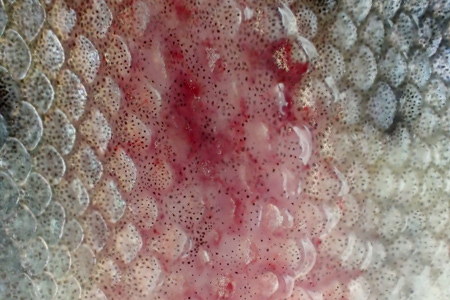Over the coming years, 500 rainbow trout in DTU Vet’s fish pen will be helping researchers increase their knowledge of red blotch disease, which is a costly problem for fish farms everywhere.
Up to a third of all Danish fish farms are affected by red blotch disease, which means they cannot sell their fish either living or whole. The fish develop red blotches on their sides, but they do not fall ill. The cause of the blotches is unknown, but Niels Jørgen Olesen, a professor in fish diseases, and his team at DTU Vet are committed to getting to the root of the problem.
When fish live in densely populated farms, diseases spread quickly. In fact, they can even spread across long distances to other farms via the water. This means that outbreaks of illness can soon result in diminished welfare for the fish, lost earnings for multiple fish farmers, and perhaps even lost income for Danish society as a whole.
In the basement facility below DTU Vet’s old buildings on Frederiksberg, veterinarians, biologists, laboratory assistants and technicians are working tirelessly to combat diseases in fish. In a one-of-a-kind ‘fish pen’ containing up to 7,000 trout and salmon that DTU raises itself, fish are subjected to the parasites, bacteria and viruses the researchers wish to study. At the moment, four tanks are filled with rainbow trout that are being examined for red blotch disease, which affects the fish skin.
"One of the advantages of running experiments on fish is that we can include a great many individuals in a single study. This produces extremely robust results compared to studies involving mammals."
Niels Jørgen Olesen, professor at DTU Vet

Researchers from the University of Stirling have already attempted to pinpoint the cause of the skin lesions, but their efforts have not yet produced a definitive conclusion. DTU Vet has therefore launched a multi-year project intended to examine the phenomenon in even greater depth. The ultimate goal is for researchers to be able to tell fish farmers what they can do to prevent the irritating complaint.
More than two years of financing have been secured for the project, through grants of DKK 1.1 million (EUR 150,00) from Henriksens Fond in Denmark and DKK 1.2 million (EUR 160,000) from the European Maritime and Fisheries Fund (EMFF).
“One of the advantages of running experiments on fish is that we can include a great many individuals in a single study. This produces extremely robust results compared to studies involving mammals. For example, this study involves around 500 fish, of which 200 are tagged with chips so we can track them individually,” relates Niels Jørgen Olesen.
Pasteurized wastewater
Working with infectious fish diseases requires highly specialized conditions. The 100 or so aquariums in the basement on Frederiksberg have been designed precisely to accommodate studies of this kind. And as it is not possible to buy fish to study that are guaranteed to be free of every imaginable disease, the researchers have no option but to raise them themselves from tiny roe.
A special water purification system—one of a kind in Denmark—prevents bacteria, viruses and other pathogens from being washed out with the waste water. All the water used in the ‘contagion tanks’ is heated to 128°C under pressure for 1–2 minutes to eliminate the risk of live sources of contagion being released.
The fish pen will be moving with DTU Vet to the Life Science & Bionegineering complex on Lyngby Campus this autumn.